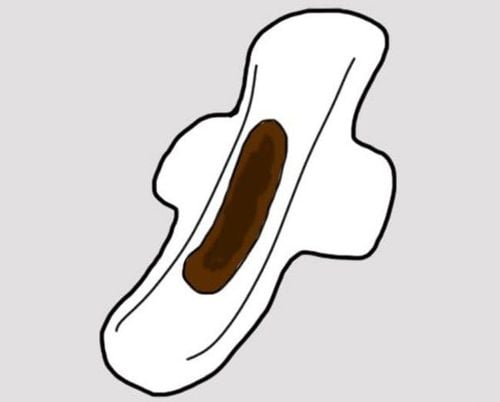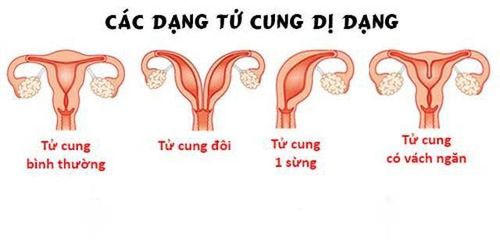This is an automatically translated article.
Female genital malformation is a structural abnormality of the genitals. The reason is that the genitals are abnormal in the process of differentiation when they are still fetuses. Female genital malformations are common in organs such as fallopian tubes, uterus, vagina, ... and can cause difficulties in sexual intercourse or reproduction in women.
1. Female genital malformation related to the vulva
The vulva, also known as the vagina, is a part of the genitals located at the outermost part of the vagina, including the other female sex organs such as the labia majora, labia minora, urethral opening, and entrance. vagina and clitoris.
Female genital malformations related to the vulva include:
Hymen is not perforated: This is a malformation of the hymen that is narrowed so that secretions from the vagina cannot come out. Unperforated hymen can be detected in newborn girls, that is, between the baby's lips there is a thin white bulging membrane. For women, the normal hymen has small holes that are not closed to the menstrual blood to escape. If the hymen is not perforated, there will be no menstrual bleeding, although the symptoms of the menstrual cycle such as breast tenderness, lower abdominal pain and back pain are still present. Therefore, if your girlfriend is 18 years old and still has not seen her period, she should go to a medical facility to check to detect abnormal female genitals. If so, it is possible to perform surgery to "create a hole" in the hymen so that menstrual blood can drain out. Lip adhesions: This is a deformity of the whole or half of the lips of the baby's lips that stick together, covering the vagina and causing difficulties in sexual intercourse, and at the same time, reproductive function is also affected.

Dị dạng sinh dục nữ là tình trạng bộ phận sinh dục bất thường về cấu trúc
2. Female genital malformation related to the vagina
The vagina is the part of the female genitalia located inside, just behind the vulva. The vagina is a tube 7 to 15 cm long that connects the vulva to the cervix. Female genital malformations related to the vagina include:
Congenital vaginal atrophy: In some cases, the structure of the ovaries, fallopian tubes and uterus in women is still normal and complete, still having the upper part of the vagina. but the lower part is atrophied and sealed. This deformity also prevents menstrual blood from escaping during the monthly menstrual period, stagnation for a long time in the abdomen, which enlarges the lower abdomen and causes abdominal pain. At that time, surgery to open a new vaginal canal is needed. No vagina: In some cases, women still have normal ovaries and uterus, but there is no vagina at all, so it leads to the condition that menstrual blood cannot exit during menstruation. It is deposited in the uterus and then spills over to the uterine horn. This type of female genital malformation requires surgery to shape the vagina and then be able to have sex and reproduce (provided that the ovaries and uterus are normal). However, it is not possible to give birth vaginally, but must have a caesarean section. Dual vagina, vagina with septum: This deformity is divided into 2 types: transverse septum and longitudinal septum. In the case of the transverse septum, it may appear in the upper or middle 1/3. This septum may or may not be perforated. If there is no perforation, it is similar to an unperforated hymen malformation. Vagina with transverse septum is a female genital malformation that is detected only during vaginal sex, provided the septum is perforated. In the case of a longitudinal septum, it may be present throughout the length of the vagina or partially accompanied by uterine malformations. This deformity makes it difficult to have sex or not be able to have intercourse because of pain, thereby affecting reproductive function in women. Females with vaginal malformations with septum need to be detected and reconstructed to make the vagina normal, so that it can have sex and reproduce. Having 2 vaginas: This is a very rare female genital malformation and can be accompanied by malformations without a uterus or with 2 uteruses. In this case, a woman can still get pregnant and give birth, however, the risk of miscarriage or premature birth is very high.

Dị dạng sinh dục nữ rất khó phát triển bình thường được
3. Female genital malformations related to the uterus
Female genital malformations related to the uterus include:
Total absence of a uterus: Without a uterus, it is impossible to menstruate, so pregnancy and childbirth cannot be achieved. Until now, medicine has not been able to perform an artificial uterus transplant surgery. There are 2 uteruses: Also known as double uterus, that is, up to 2 uteruses in the pelvis and share a vagina or each uterus connects to a separate vagina. If one of the two uteruses is normal, there is still a possibility of pregnancy, but this female genital malformation is very difficult to develop normally. Therefore, it is necessary to be detected and examined to evaluate the status and function of each uterus. Treatment is mainly surgical removal of the underdeveloped, degenerated uterus and retaining the fully developed uterus. Septated uterus: This is a common abnormality of female genitalia, is a condition in which the septum between the uterus forms two fully or partially fused uteruses. This malformation can be detected by X-ray, ultrasound, laparoscopy. Women with a septate uterus may have difficulty getting pregnant, and have a high risk of fetal growth failure or miscarriage. However, it can be treated with surgery to restore the normal shape of the uterus. Small uterus: This female genital malformation, also known as a female uterus, is a condition in which the uterus is underdeveloped, only as large as a girl's uterus and often accompanied by abnormalities such as no vagina, no ovaries, resulting in the inability to become pregnant and reproduce. If the uterus is small but the ovarian function is completely normal, it is still possible to give birth by IVF. Unicornuate uterus: This is a condition where there are only 1 fallopian tube and 1 ovary on one side. This malformation makes it more difficult for women to get pregnant.

Dị dạng sinh dục nữ thường phát triển từ khi còn là bào thai
4. Female genital malformations related to ovaries and fallopian tubes
Female genital malformations involving the ovaries and fallopian tubes include:
No ovaries: Females may have only one ovary on one side and may or may not have a fallopian tube, or no ovaries at all. which eggs. If the ovaries are normal and function normally, there is still a possibility of pregnancy, but without the ovaries, there is no possibility of fertility. The opposite of having no ovaries is having too many ovaries. The ovaries are located in an abnormal location: The ovaries can be located in the lumbar region or in the groin. Excess fallopian tube, fallopian tube: With normal structure, each ovary corresponds to 1 fallopian tube, and when female genitalia are abnormal, there may be excess fallopian tubes, ie 1 ovary but up to 2 fallopian tubes. . Similarly, each oviduct corresponds to 1 tubal loudspeaker, but the deformity is that 1 oviduct has up to 2 tubal lobes. Incompatibility between internal and external genitalia: This is a condition in which the internal and external sex organs develop incompatible with each other during differentiation. For example, a woman has a normal uterus and ovaries, but has a deformity that is the clitoris develops edematously, as large as a penis, the large lips develop and sag looking like the scrotum in men, but no testicles inside. Or the case of abnormal female genitals inside such as no ovaries, uterus, but there are testicles in the scrotum and the external structure looks similar to that of a woman. Female genital malformations often develop during pregnancy and continue to develop after birth, affecting sex determination and fertility. Therefore, it is necessary to detect early for timely surgery and help children develop and live normally.
Please dial HOTLINE for more information or register for an appointment HERE. Download MyVinmec app to make appointments faster and to manage your bookings easily.













